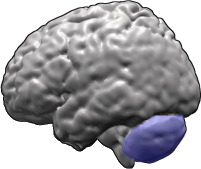Definition
Friedreich's ataxia (FA) is an inherited, progressive nervous system disorder causing loss of balance and coordination.
Description
Ataxia is a condition marked by impaired coordination. Friedreich's ataxia is the most common inherited ataxia, affecting between 3,000-5,000 people in the United States. FA is an autosomal recessive disease, which means that two defective gene copies must be inherited to develop symptoms, one from each parent. A person with only one defective gene copy will not show signs of FA, but may pass along the gene to offspring. Couples with one child affected by FA have a 25% chance in each pregnancy of conceiving another affected child.
Causes & symptoms
Causes
The gene for FA codes for a protein called frataxin. Normal frataxin is found in the cellular energy structures known as mitochondria, where it is involved in regulating the transport of iron. In FA, the frataxin gene is expanded with nonsense information known as a "triple repeat." This extra DNA interferes with normal production of frataxin, thereby impairing iron transport. FA is thought to develop at least in part because defects in iron transport prevent efficient use of cellular energy supplies.
The nerve cells most affected by FA are those in the spinal cord involved in relaying information between muscles and the brain. Tight control of movement requires complex feedback between the muscles promoting a movement, those restraining it, and the brain. Without this control, movements become uncoordinated, jerky, and inappropriate to the desired action.
Symptoms
Symptoms of FA usually first appear between the ages of 8 and 15, although onset as early as 18 months or as late as age 25 is possible. The first symptom is usually gait incoordination. A child with FA may graze doorways when passing through, for instance, or trip over low obstacles. Unsteadiness when standing still and deterioration of position sense is common. Foot deformities and walking up off the heels often results from uneven muscle weakness in the legs. Muscle spasms and cramps may occur, especially at night.
Ataxia in the arms follows, usually within several years, leading to decreased hand-eye coordination. Arm weakness does not usually occur until much later. Speech and swallowing difficulties are common. Diabetes mellitus may also occur. Nystagmus, or eye tremor, is common, along with some loss of visual acuity. Hearing loss may also occur. A side-to-side curvature of the spine (scoliosis) occurs in many cases, and may become severe.
Heartbeat abnormalities occur in about two thirds of FA patients, leading to shortness of breath after exertion, swelling in the lower limbs, and frequent complaints of cold feet.
Diagnosis
Diagnosis of FA involves a careful medical history and thorough neurological exam. Lab tests include electromyography, an electrical test of muscle, and a nerve conduction velocity test. An electrocardiogram may be performed to diagnose heart arrhythmia.
Direct DNA testing is available, allowing FA to be more easily distinguished from other types of ataxia. The same test may be used to determine the presence of the genetic defect in unaffected individuals, such as siblings.
Treatment
There is no cure for FA, nor any treatment that can slow its progress. Amantadine may provide some limited improvement in ataxic symptoms, but is not recommended in patients with cardiac abnormalities. Physical and occupational therapy are used to maintain range of motion in weakened muscles, and to design adaptive techniques and devices to compensate for loss of coordination and strength. Some patients find that using weights on the arms can help dampen the worst of the uncoordinated arm movements.
Heart arrhythmias and diabetes are treated with drugs specific to those conditions.
Prognosis
The rate of progression of FA is highly variable. Most patients lose the ability to walk within 15 years of symptom onset, and 95% require a wheelchair for mobility by age 45. Reduction in lifespan from FA complications is also quite variable. Average age at death is in the mid-thirties, but may be as late as the mid-sixties. As of mid-1998, the particular length of the triple repeat has not been correlated strongly enough with disease progression to allow prediction of the course of the disease on this basis.
Prevention
There is no way to prevent development of FA in a person carrying two defective gene copies.
Key Terms
- Ataxia
- A condition marked by impaired coordination.
- Scoliosis
- An abnormal, side-to-side curvature of the spine.
Further Reading
For Your Information
Books
- "Spinocerebellar Degeneration (Friedreich's Ataxia)." In Harrison's Principles of Internal Medicine, edited by Kurt J. Isselbacher et al. New York: McGraw-Hill, 1994, 2285.
Periodicals
- Quest. Available from the Muscular Dystrophy Association.
Organizations
- Muscular Dystrophy Association. 3300 East Sunrise Drive, Tucson, AZ 85718. (520) 529-2000 or (800) 572-1717. http://www.mdausa.org.
Gale Encyclopedia of Medicine. Gale Research, 1999.



